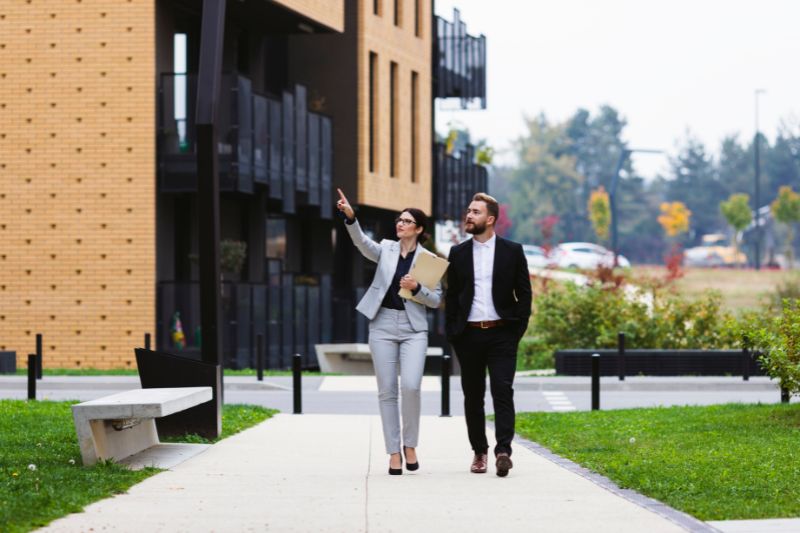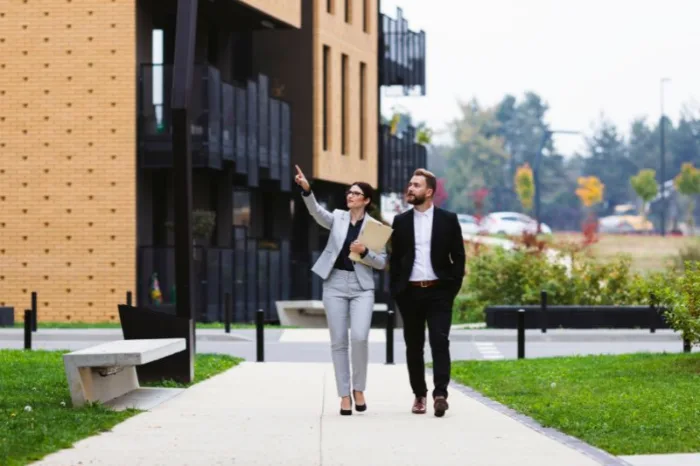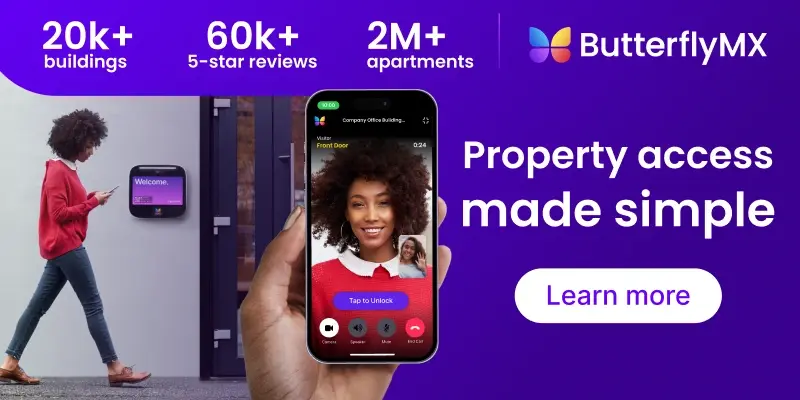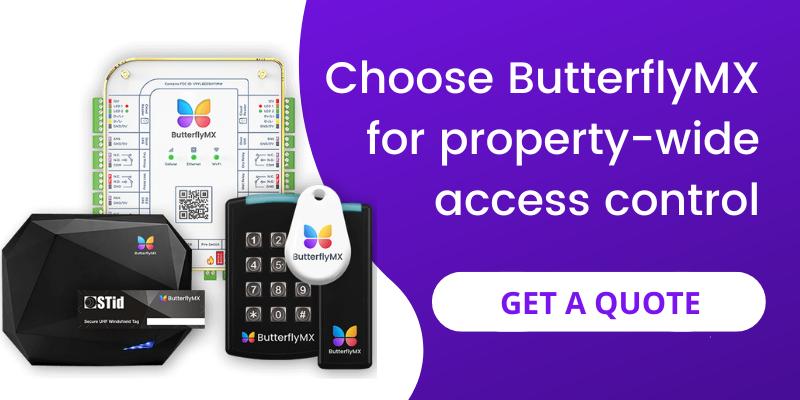Key takeaways
- Property managers are responsible for a wide range of tasks to ensure the smooth operation of multifamily properties, including leasing management.
- Property staff help manage all types of property entrances, including shared, private, and vehicle entrances.

As a property manager or owner, you know that the evolving world of property management centralization is becoming increasingly competitive. And with so much on your plate in terms of maintaining your property and helping it thrive, you need the best methods to control property access and management.
In this post, we guide you through the concept of leveraging advanced property technology and software to simplify access management.
First, we’ll give you a glimpse of the best property access management system and how it will simplify the job of managing your property. Then, discover the core functions of a property manager, which gives a clear vision of the responsibilities that need to be mastered. Finally, find out how to manage different types of property access points.
In this post, discover:
- What is the best property access management system?
- What are the basic functions of a property manager?
- How does property access management work?
- How to manage property access
What is the best property access management system?
The best property access system is ButterflyMX because of its property-wide access capabilities. ButterflyMX is installed in over 10,000 buildings and has over 20,000 five-star ratings, making it a popular choice for multifamily and commercial properties across the country.
Property access management products from ButterflyMX include:
- Front Desk Station
- Amenity Reservations
- Elevator Controls
- Package Room
- Vehicle Access Control
- Mobile App
1. Front Desk Station
The Front Desk Station from ButterflyMX is a visitor management software that can be loaded onto your organization’s computer. This software enables you to monitor movement in your building via a live video stream — increasing overall security. Moreover, you can also interact with guests using the Video Intercom, which is also from ButterflyMX.
2. Amenity Reservations
Empower residents to reserve building amenities at any time by allowing them to easily check space availability and associated fees, as well as book amenities for themselves and their guests via the ButterflyMX mobile app. With this feature, property staff can configure their amenity spaces in our cloud-based dashboard in just a few clicks.
3. Elevator Controls
Elevator Controls allow residents to unlock key-fobbed elevators — further proving that ButterflyMX is an asset centralization to your centralization efforts. With this feature, residents don’t have to keep key fobs and cards for several different entry methods. They have everything they need in one top-rated mobile app.
4. Package Room
The Package Room, equipped with the ButterflyMX wide-angle Video Intercom, simplifies package management for tenants and staff. With a designated PIN, deliverers can leave packages in the room, and residents can retrieve them when they’re ready.
5. Vehicle Access Control
The ButterflyMX Vehicle Access Control consists of a vehicle reader and windshield tags. With this system, property managers can remotely update the database of resident vehicle tags. Drivers simply apply the Windshield Tag to their vehicle. Then, as they approach the gate, the reader scans the tag, granting them access.
6. Mobile app
With our top-rated smartphone app, residents can find everything they need. This includes a Swipe-to-Open button for a touchless entry experience and a two-way video where they can see anyone requesting entry access.
Further, in the ButterflyMX mobile app, you can video chat with visitors and maintenance workers and grant them access from anywhere in the world.
Discover five ways to automate your building for more benefits:
What are the basic functions of a property manager?
Property managers are responsible for a wide range of tasks to ensure the smooth operation of multifamily properties.
Basic functions of property managers include:
- Leasing. Handling lease agreements, conducting property tours, and managing tenant applications.
- Maintenance and repairs. Coordinating regular maintenance, addressing repair requests, and ensuring properties are well-maintained.
- Tenant relations. Addressing tenant concerns, facilitating communication, and ensuring tenant satisfaction.
- Financial management. Managing budgets, collecting rent, and ensuring financial stability.
- Compliance. Ensuring properties adhere to local, state, and federal regulations.
- Managing property access. Property managers manage access to the property by monitoring entry actions by credentialed residents and non-credentialed visitors.
How does property access management work?
Property access management works by:
- Enhancing security. Property access restricts access to authorized individuals, reduces the risk of unauthorized entry, and enhances overall security.
- Enabling remote monitoring. Property managers can monitor and control access remotely, ensuring they can respond to issues quickly, even when off-site. What’s more, they can easily update databases and monitor photo audits.
- Creating convenience. Automated access systems reduce the need for physical keys, making it easier for residents and staff to access the property. Furthermore, most modern systems now make it possible to use smartphone apps as entry credentials.
- Improving management. Access control data provides valuable insights into property usage patterns, helping managers make informed decisions.
How to manage property access
When you manage a large property with multiple entrance and exit points, it can be a large task to figure out how to manage access in a secure way. Below, we’ve put together a guide on how to manage access to the different types of points on your property.
Learn how to manage property access to:
Shared entrances
For buildings with shared entrances, such as apartment complexes, access control is crucial for maintaining security and convenience.
Key strategies include:
- Electronic key fobs and cards. Residents use electronic key fobs or cards to enter the building, reducing the risk of lost or copied keys. Scalable databases mean you can update the directory without losing space.
- Intercom systems. Allow residents to verify and grant access to visitors remotely. They can also use two-way communication to see who they’re granting access to.
- CCTV monitoring. Enhances security by monitoring entrances and common areas without disrupting the flow of traffic or being too noticeable.
Private entrances
Properties with private entrances, such as townhouses or individual units, require a different approach to access management.
Here are ways to manage access to private entrances:
- Smart locks. With smart locks, residents can use their smartphones to unlock doors, providing convenience and eliminating the need for physical keys. What’s more, they can even unlock their door remotely if they need to let someone in while they aren’t home.
- Visitor passes. Temporary passcodes can be issued to visitors, service personnel, or delivery workers using a smartphone app. Moreover, these temporary passcodes can be updated or revoked at any time by property managers using the online portal.
- Video intercoms. Enhance security by allowing residents to see and communicate with visitors via their smartphones before granting access.
Vehicle entrances
Many properties have resident parking that needs to allow access to residents and credentialed vehicles.
Managing vehicle access is essential for properties with parking lots or garages:
- Automated gates. Controlled by electronic key fobs, access codes, or license plate recognition systems, an automated gate will help residents enter and exit without difficulty.
- Vehicle management systems. Vehicle management systems, such as vehicle readers with windshield tags, make it easy for residents to come and go without having to stop and roll down their windows. What’s more, a vehicle access control system will help visitors call someone in the building to request access to parking.
- Surveillance cameras. Cameras ensure the security of parking areas and deter unauthorized access by helping property managers visually account for parking areas from anywhere.







